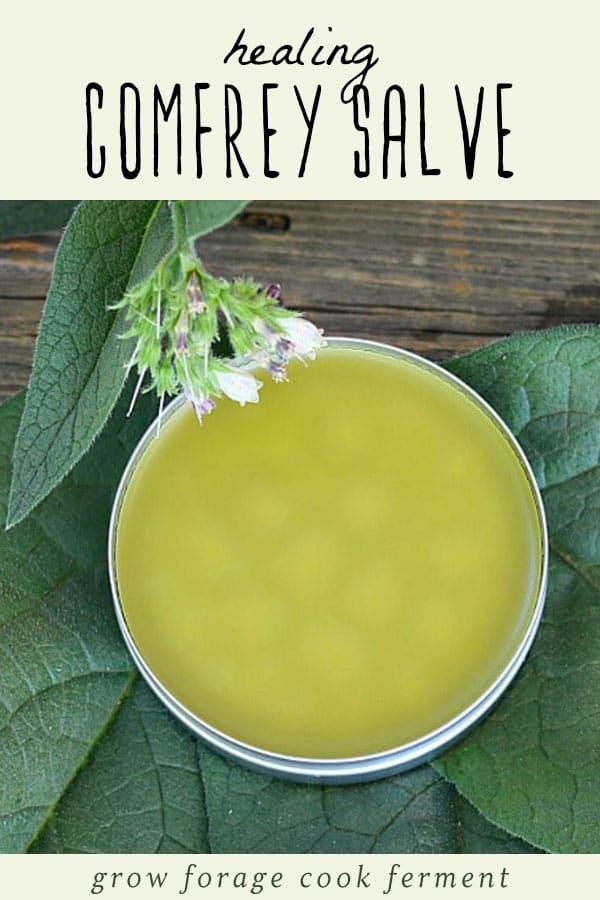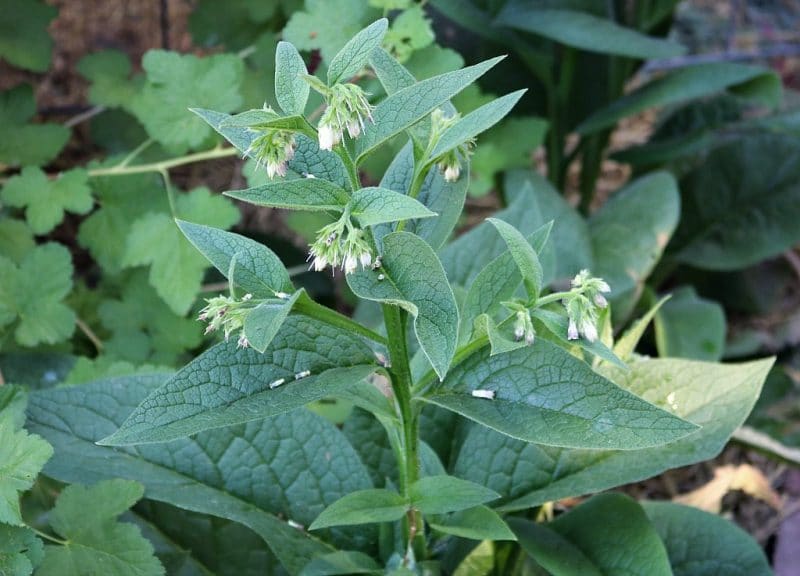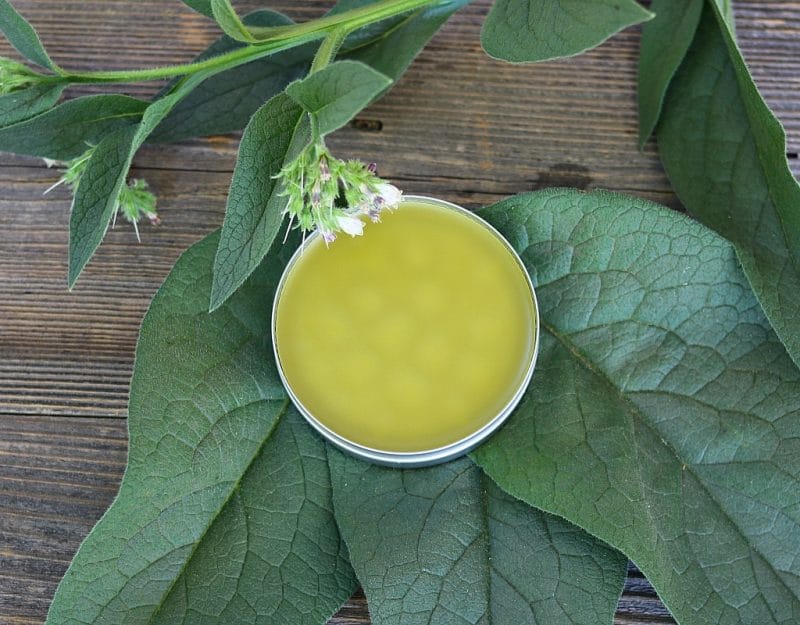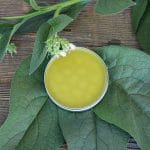Learn how to make your own homemade comfrey salve. Comfrey (Symphytum officinale) has traditionally been used in herbal preparations. Some studies suggest that it contains allantoin, which may support skin cell regeneration, and rosmarinic acid, which has been explored for its potential anti-inflammatory properties.

Want to save this post for later?
Medicinal Benefits of Comfrey
I’m always amazed by the power of herbal medicine!
This homemade comfrey salve is a popular choice for skin care, often used by herbalists in combination with other plant-based ingredients like calendula and plantain. However, it should not be applied to deep or infected wounds, as it may promote surface healing before addressing underlying concerns.
Comfrey has been studied for its potential effects on skin health, but it contains pyrrolizidine alkaloids, which are known to be toxic if absorbed in significant amounts. Because of this, internal use is discouraged, and topical use should be limited to unbroken skin for short periods.
According to Very Well Health, you should avoid applying comfrey preparations to broken or abraded skin, which can increase the risk of toxin absorption. You should also limit the duration of topical use to no more than 10 consecutive days, and avoid using comfrey products for more than 4 to 6 weeks in a year.
Beyond skincare, comfrey is also valued in gardening for its use as a natural compost and DIY fertilizer! It is a plant that I will always have growing in my medicinal herb garden, even if it does have a tendency to spread.

How to Make Comfrey Infused Oil
Before making this salve, you will need to make a comfrey infused oil.
I use dried comfrey leaf that I harvest from my garden and dry on homemade drying screens.
You can also purchase organic dried comfrey leaf from Mountain Rose Herbs.
Fill a pint jar about ½ to ⅔rds full of dried comfrey leaf, then cover the plant material with your carrier oil of choice.
You can use a single carrier oil or a combination of oils. My favorite combination for making salves is equal parts of olive, coconut, and sweet almond oils.
Let the oil infuse in a cool and dark place for 4-6 weeks (or longer) before making this salve. Strain out the comfrey leaf before using in this recipe.
Comfrey Salve Recipe
To make the salve, first create a makeshift double boiler by putting a small bowl or a glass Pyrex measuring cup over a pot with about an inch of simmering water.
Put the comfrey oil and beeswax into the small bowl or Pyrex, and heat until the beeswax completely dissolves into the oil, stirring occasionally.
Add the shea butter and stir until it completely dissolves.
Carefully pour the mixture into small jars or tins and let sit until the salve sets up completely.

This comfrey salve is one that I always have on hand in my herbal medicine cabinet.
Comfrey has so many healing benefits, and this salve is amazing for healing minor cuts, scrapes, and wounds. It really works wonders!
Herbal Salve Recipes
Here are some other herbal salve recipes you may like:
- Dandelion Salve
- How to Make a Yarrow Plant Salve
- Plantain Salve
- Calendula Salve
- St. John’s Wort Salve
- How to Make an Herbal Salve
- Herbal Bug Balm Salve
- Diaper Rash Salve
- 10 Herbal Salve Recipes
- Pine Salve
Comfrey Salve
Ingredients
Comfrey Infused Oil
- 2 cups carrier oil of choice
- 1 cup dried comfrey leaves
Comfrey Salve
- 1 cup comfrey infused oil
- 1 ounce beeswax
- 1 ounce refined shea butter
Instructions
Comfrey Infused Oil
- Fill a pint jar about ½ to ⅔rds full of dried comfrey leaf, then cover the plant material with your carrier oil of choice.
- Let the oil infuse in a cool and dark place for 4-6 weeks (or longer).
- Strain out the comfrey leaf before using in this recipe.
Comfrey Salve
- Create a makeshift double boiler by putting a small bowl or a glass Pyrex measuring cup over a pot with about an inch of simmering water.
- Put the comfrey oil and beeswax into the small bowl or Pyrex, and heat until the beeswax completely dissolves into the oil, stirring occasionally.
- Add the shea butter and stir until it completely dissolves.
- Carefully pour the mixture into small jars or tins and let sit until the salve sets up completely.




I recently discovered a jar of dried comfrey leaves soaking in oil in a back cupboard. They may have been there for years. Oops… That’s embarrassing. Can they still be strained and used?
As long as the liquid isn’t black, which means it’s oxidized, it should be fine!
The Pyrrolizidine alkaloids, the toxic part in comfrey is not oil soluble, therefore salves and oils should be perfectly safe. If using topically as a concoction or poultice it should probably be limited to 11 days to 3 weeks
Second comment:
Does this recipe work for any topical herb??
Yes!
Question. Can I make a fine powder to speed up the infusion process? If so, how much would it speed up??
Probably not much, since it would also make it difficult to strain.
I am making whipped tallow with comfrey. And I love it. Can I add spearmint within to infuse?
Sure, that should be fine, although you make have a hard time getting the fragrance to come through. If that’s what you’re aiming for, I suggest adding a drop or two of spearmint essential oil.
Hi there Colleen
I’m ready to make the comfrey salve. I’m just wondering if I can use coconut oil (hard at room temp) I place of beeswax and/or other butters.
Thanks
Karleen
Hi Karleen. Yes, you can use it, but just know it won’t be as hard as beeswax and is more finicky (it melts around 78 degrees). It would be best to keep it refrigerated to ensure it says solid.
Can Bocking 14 comfrey be used in the place of the common or official comfrey?
Yes, that should work!
Thanks for the recipe. My salve came out to thick. Can I remelt it with more olive oil?
Of course!
Instead of letting it sit for 4-6 weeks. Can I substitute the magic butter infusion? I ask because I currently make tincture and infused oil using it. I de-carb first then infuse to carrier oil for 4/5 hours using the machine?
I ask because some herbs require the sitting option.
Where can I purchase comfrey plants? When you say in your recipe to add green comfrey oil, do mean what you made allowing 6 weeks?
Would this help plants in the garden?
You can buy comfrey seeds pretty much anywhere that sells medicinal seeds. Mountain Rose Herbs, Strictly Medicinal Seeds, etc. I couldn’t find anywhere in the recipe that says “green comfrey oil” but the salve is made with the comfrey infused oil I made in the first half of the recipe.
Can cocoa butter be used as a substitute for shea butter?
Yup!
I’m going to be making some comfrey salve soon. I didn’t know you could “cook” it. Did you use high or low setting for 3 hours? I have been growing comfrey for a few years. I don’t understand why mine doesn’t grow up like yours and other pictures I’ve seen. My comfrey grows out, not up.
Hi Brenda. I’m not sure what you mean by cooking it, but if you mean infusing it with heat, yes, you can put the dried comfrey and carrier oils in a double boiler or slow cooker and simmer for 2-6 hours to speed up the infusion.
Hello
Great salves. Thank you for sharing all these recipes. Comfrey salve is the one I most use
hi there. you don’t mention how much Shea butter to use in the comfrey salve recipe. Please inform. Also, can I add celery seeds and how would I do that? I had a salve with them in it and am wondering if that ingredient has made my skin so soft. Thank You so much!!!!
Many blessings to you-
Nina Nathan
Hi Nina, did you scroll down the page to the recipe card? It says you’ll need one ounce of shea butter. I’ve never used a salve with celery seeds before, so I’m not sure how much you should use, but if you want to try, I would suggest adding them to the infused oil.
For your carrier oil combo, do you use fractionated coconut oil?
Hi Kat. I use refined coconut oil, but you definitely could use fractionated.
I’ve been making infused oils & salves for 16 years and have never experienced them going rancid. I store them in a cool dry place. While the viscosity may stiffen over time and the potency of the phytochemicals will decrease, using vitamin E as a preservative works very well. Use 4 drops to a cup of infused oil at the end of processing.
Hi. I made this comfrey salve per recipe. and like it a lot. However, the texture has become grainy after a couple of weeks? Did I do something wrong? Do I need to temper the fat mixture? Thank you.
Some oils, like shea butter, when exposed to different temperatures melt and recrystallize if they aren’t cooled rapidly. I will usually keep my homemade salves refrigerated to ensure they’re always at a consistent temperature.
Hi! Why refined shea butter? can be unrefined? what’s the difference?
Thank you!!!
Hi there, you can use unrefined, but be aware that it does have a strong scent that not everyone likes. Refined shea butter has no scent.
This salve has been in the making for a long time. I bought the seeds grew the plants and had misplaced the recipe. Finally dried the leaves -soaked the leaves- and today made the salve. Anxious to give it a try.
My only suggestion is you show a 1 cup pyrex. By the time you add the beeswax and Shea it overflows. Thanks again for sharing
Hello! I am making a healing salve with comfrey, calendula and plantain. I was thinking about adding some cannabis but can’t find anything on the net about mixing these herbs. Do you have any thoughts?
Thank you
Hi Jennifer, I think that sounds like a great combination!
I had made a tincture of comfrey, lavendar and lambs ear with vodka. Was ready to put it in dropper bottles when I saw comfrey should not be ingested. Would it work as a topical spray, or addition to a poultice? Would it work to use it with beeswax and/or shea butter since it is vodka and not oil? I hate to waste it…..
I drink one comfrey leaf twice a week it cured all my pain.One comfrey leaf,one glass of water,one glass of ice goes into my vitamix blender for one minute then its bottoms up tastes like a mild cucumber juice and abra cadabra no more back pain and no more arthritus pain in my hands or hip.More people die of aspirin every day of the week then have died of comfrey in recorded history.
How big of a comfrey leaf are you talking here
Apparently the liver toxicity associated with consuming comfrey is from using very high doses over an extended period of time… as in 10 cups a day of steeped tea over several weeks… it’s not recommended to be a regular part of your tea consumption but I don’t think it sounds dangerous in acute situations when used only temporarily (just from what I have read so far…)
I certainly wouldn’t throw out what sounds like a good tincture you’ve made!
After i strain my comfrey and am left with my infused oils, does it get harder, more like an ointment, less like an oil? Also, how long before it gets rancid?
No it won’t get harder unless you add some beeswax and/or some kind of butter like shea butter. If you use dried comfrey leaves and store the oil away from heat and light it will stay good for up to a year or more.